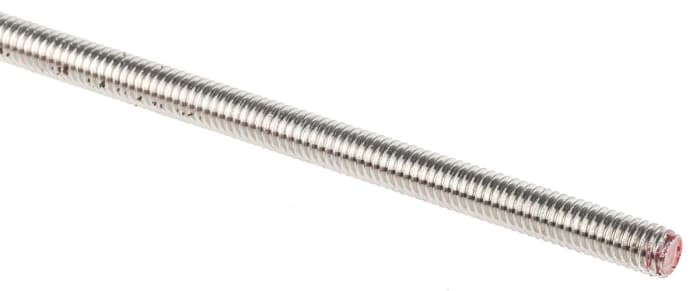RS PRO Plain Brass Threaded Rod, M3, 1m

Technical Document
Specifications
Brand
RS ProThread Size
M3
Material
Brass
Length
1m
Thread Length Style
Fully Threaded
Finish
Plain
Standards Met
DIN 976
Country of Origin
Taiwan, Province Of China
Product details
RS PRO A4 Stainless Steel 1m Metric Threaded Rod
These 1m brass metric threaded rods are fully threaded and made of CZ121 leaded brass, with a range of thread sizes available: M3 (RS: 4687077), M4 (RS: 4687083), M5 (RS: 4687106), M6 (RS: 4687112), M8 (RS: 4687128), and M10 (RS: 4687134).
Features and Benefits
- DIN975 standards
- Type CZ121 leaded brass
- Fully threaded
Frequently Asked Questions
What are threaded rods?
Threaded rods, also referred to as studs, are helically-threaded rods made of metal, such as steel, brass and stainless steel, or sometimes plastic, like nylon. Similar to screws but without a head, these rods combine linear and rotational movement to create a strong fastening bond between materials, with the thread allowing for nuts and bolts to also be used when required. As these rods are designed to withstand very high levels of pressure and tension, they are commonly used in support systems among a variety of other applications.
What are they made of?
These threaded rods are made of CZ121 leaded brass, which is the European standard grade of brass for free-machining due to its suitability for high-speed machining operations and the manufacture of intricate parts. With a duplex structure and an additional 3% lead, CZ121 leaded brass is harder and stronger than other brass alloys, which is why it is often used in architectural extrusions.
What are they used for?
Threaded rods have many applications, acting as a pin to fasten, hold or connect two materials together. The threading on the rod provides a tightening action, using friction to hold the fastening together. Threaded rods can be used with woods, metals and even concrete to provide either a permanent or temporary base to support projects. This especially applies to construction projects, such as studding concrete foundations to provide additional support.
Stock information temporarily unavailable.
P.O.A.
Each (In a Pack of 2) (Exc. Vat)
2
P.O.A.
Each (In a Pack of 2) (Exc. Vat)
Stock information temporarily unavailable.
2
Technical Document
Specifications
Brand
RS ProThread Size
M3
Material
Brass
Length
1m
Thread Length Style
Fully Threaded
Finish
Plain
Standards Met
DIN 976
Country of Origin
Taiwan, Province Of China
Product details
RS PRO A4 Stainless Steel 1m Metric Threaded Rod
These 1m brass metric threaded rods are fully threaded and made of CZ121 leaded brass, with a range of thread sizes available: M3 (RS: 4687077), M4 (RS: 4687083), M5 (RS: 4687106), M6 (RS: 4687112), M8 (RS: 4687128), and M10 (RS: 4687134).
Features and Benefits
- DIN975 standards
- Type CZ121 leaded brass
- Fully threaded
Frequently Asked Questions
What are threaded rods?
Threaded rods, also referred to as studs, are helically-threaded rods made of metal, such as steel, brass and stainless steel, or sometimes plastic, like nylon. Similar to screws but without a head, these rods combine linear and rotational movement to create a strong fastening bond between materials, with the thread allowing for nuts and bolts to also be used when required. As these rods are designed to withstand very high levels of pressure and tension, they are commonly used in support systems among a variety of other applications.
What are they made of?
These threaded rods are made of CZ121 leaded brass, which is the European standard grade of brass for free-machining due to its suitability for high-speed machining operations and the manufacture of intricate parts. With a duplex structure and an additional 3% lead, CZ121 leaded brass is harder and stronger than other brass alloys, which is why it is often used in architectural extrusions.
What are they used for?
Threaded rods have many applications, acting as a pin to fasten, hold or connect two materials together. The threading on the rod provides a tightening action, using friction to hold the fastening together. Threaded rods can be used with woods, metals and even concrete to provide either a permanent or temporary base to support projects. This especially applies to construction projects, such as studding concrete foundations to provide additional support.





